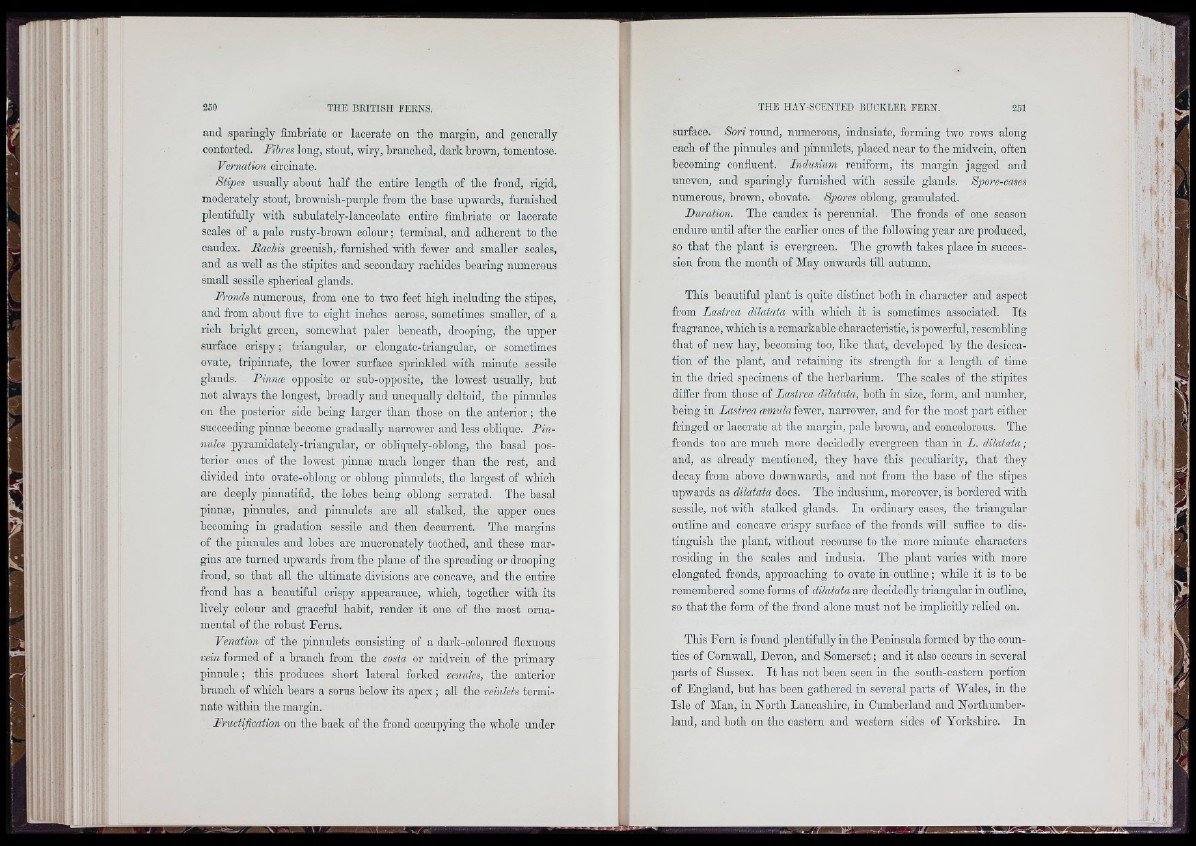
and sparingly fimbriate or lacerate on tho margin, and generally
contorted. Fibres long, stout, wiry, branched, dark brown, tomentose.
Vernation circinate.
Stipes usually about half the entire length of the frond, rigid,
moderately stout, brownish-purple from the base upwards, furnishod
plentifully with suhulatcly-lanceolatc entire fimbriate or lacerate
scales of a pale rusty-brown colour ; terminal, and adherent to the
caudex. Rachis greenish, furnished with fewer and smaller scales,
and as woll as the stipites and secondary raohides hearing numerous
small sessile spherical glands.
Fronds numerous, from one to two feot high including the stipes,
and from about five to eight inches across, sometimes smaller, of a
rich bright green, somewhat paler beneath, drooping, the upper
surface crispy ; triangular, or elongate-triangular, or somotimos
ovate, tripinnate, the lower surface sprinkled with minute sessile
glands. Rinnm opposite or suh-opposite, the lowest usually, but
not always the longest, broadly and unequally deltoid, tho pinnules
on the posterior side hoing larger than those on the anterior; the
suooeeding pinnæ become gradually narrower and less oblique. Pinnules
pyramidatoly-triangular, or obliquely-ohlong, the basal posterior
ones of the lowest pinnæ much longer than the rest, and
divided into ovate-ohlong or oblong pinnulots, the largest of which
are deeply pinnatifid, tho lobes being oblong serrated. The basal
pinnæ, pinnules, and pinnulets are all stalked, the upper ones
heooming in gradation sessile and then decurrent. The margins
of the pmnules and lobes aro mucronately toothed, and these margins
are turned upwards from the plane of tho spreading or drooping
frond, so that all the ultimate divisions are concave, and the entire
frond has a beautiful crispy appearance, which, together with its
lively colour and graceful habit, render it one of the most ornamental
of the robust Ferns.
Venation of the pinnulets consisting of a dark-coloured flexuous
vein formed of a branch from the costa or midvem of the primary
pinnule ; this produces short lateral forked venules, the anterior
branch of which hears a sorus below its apex ; all the veinlets terminate
within tho margin.
Fructifleation on tho hack of the frond occupying tho whole under
surface. Sori round, numerous, indusiate, forming two rows along
each of the pinnules and pinnulets, placed near to the midvoin, often
heooming confluent. Indusium reniform, its margin jagged and
uneven, and sparingly furnished with sessile glands. Spore-cases
numerous, brown, obovate. Spores oblong, granulated.
Duration. The caudex is perennial. The fronds of one season
endure until after the earlier ones of the following year arc produced,
so th a t the plant is evergreen. The growth takes place in succession
from the month of May onwards till autumn.
This beautiful plant is quite distinct both in oharaoter and aspect
from Lastrea dilatata with which it is sometimes associated. Its
fragrance, which is a remarkable oharaoteristio, is powerful, resembling
th a t of new hay, heooming too, like that, developed by the desiccation
of the plant, and retaining its strength for a length of time
in tho dried specimens of the herbarium. The scales of the stipites
differ from those of Lastrea dilatata, both in size, form, and number,
being in Lastrea mmula fewer, narrower, and for the most part either
fringed or lacerate at the margin, pale brown, and concolorons. The
fronds too are much moro decidedly evergreen than in L. dilatata ;
and, as already mentioned, they have this peculiarity, that they
decay from above downwards, and not from the base of the stipes
upwards as dilatata does. Tho indusium, moreover, is bordered with
sessile, not with stalked glands. In ordinary oases, the triangular
outline and concave crispy surface of the fronds will suffice to distinguish
the plant, without recourse to tho more minute characters
residing in the scales and indusia. The plant varies with more
elongated fronds, approaching to ovate in outline ; while it is to be
remembered some forms of dilatata are decidedly triangular in outline,
so th a t the form of the frond alone must not bo imphoitly rehed on.
This Fern is found plentifully in the Peninsula formed hy the counties
of Cornwall, Devon, and Somerset ; and it also occurs in several
parts of Sussex. I t has not boon seen in the south-eastern portion
of England, hut has been gathered in several parts of Wales, in tho
Isle of Man, in North Lancashire, in Cumhorland and Northumberland,
and both on the eastern and western sides of Torkshiro. In